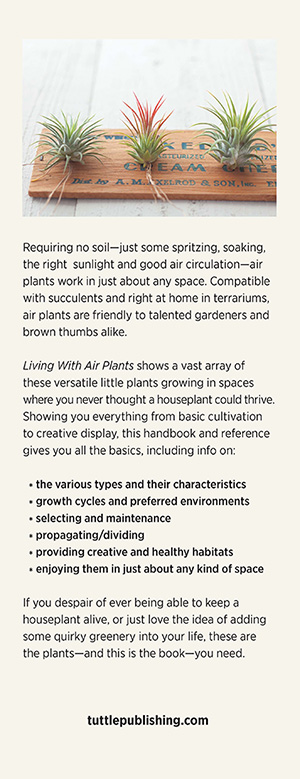

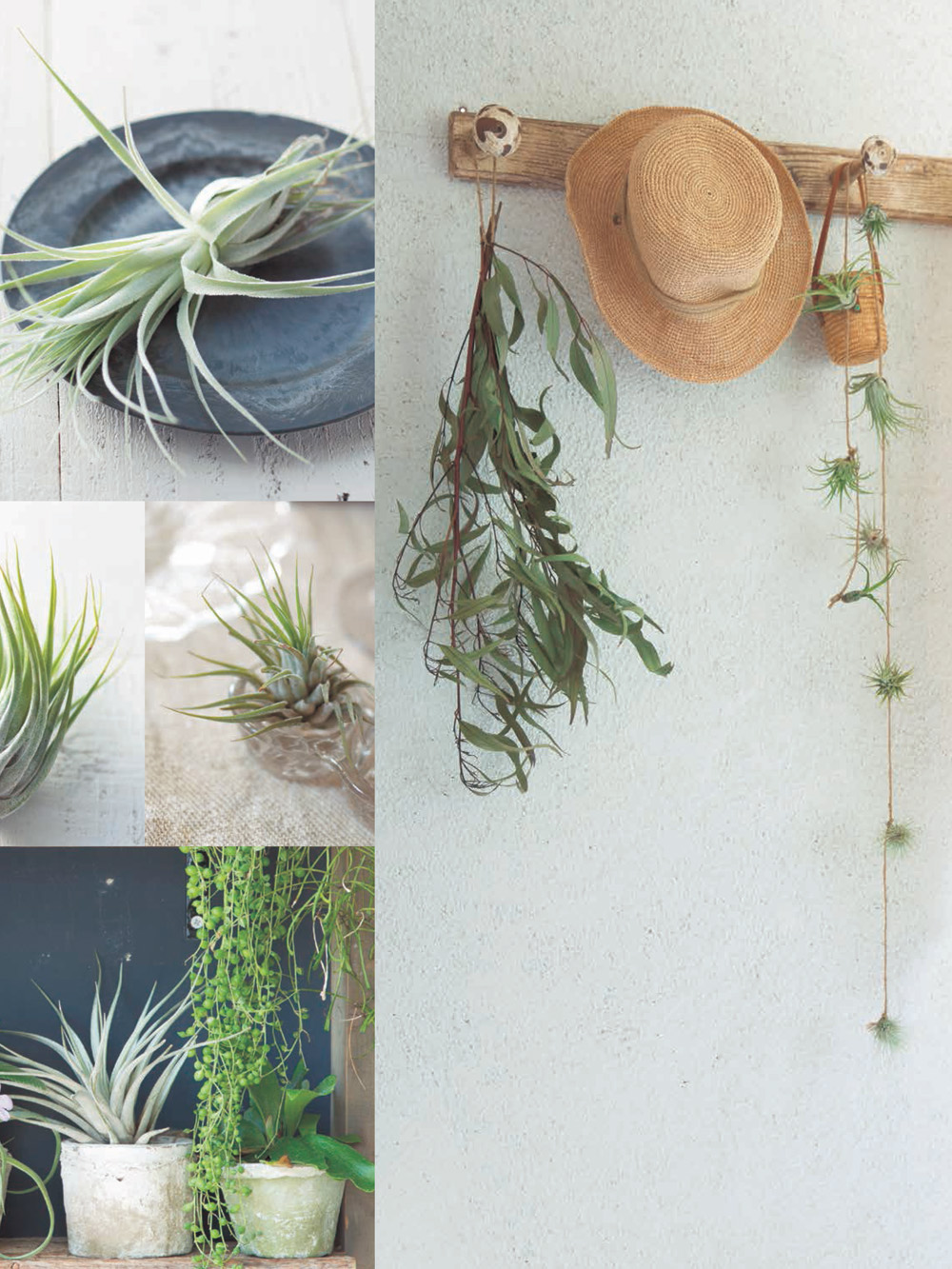 LIVING WITH AIR PLANTS A Beginners Guide to Growing and Displaying Tillandsia
LIVING WITH AIR PLANTS A Beginners Guide to Growing and Displaying Tillandsia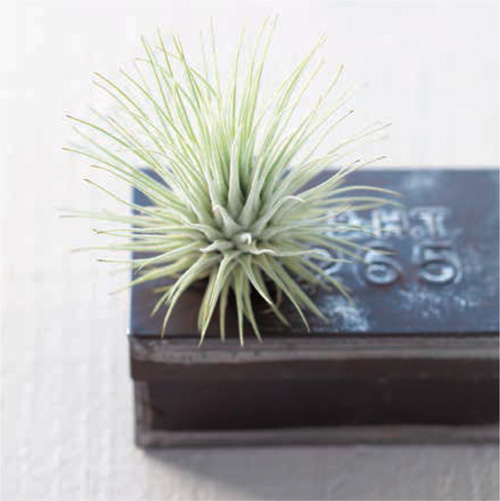 PROTOLEAF Yoshiharu Kashima BROCANTE Yukihiro Matsuda STYLING DIRECTION
PROTOLEAF Yoshiharu Kashima BROCANTE Yukihiro Matsuda STYLING DIRECTION  Authors Note
Authors Note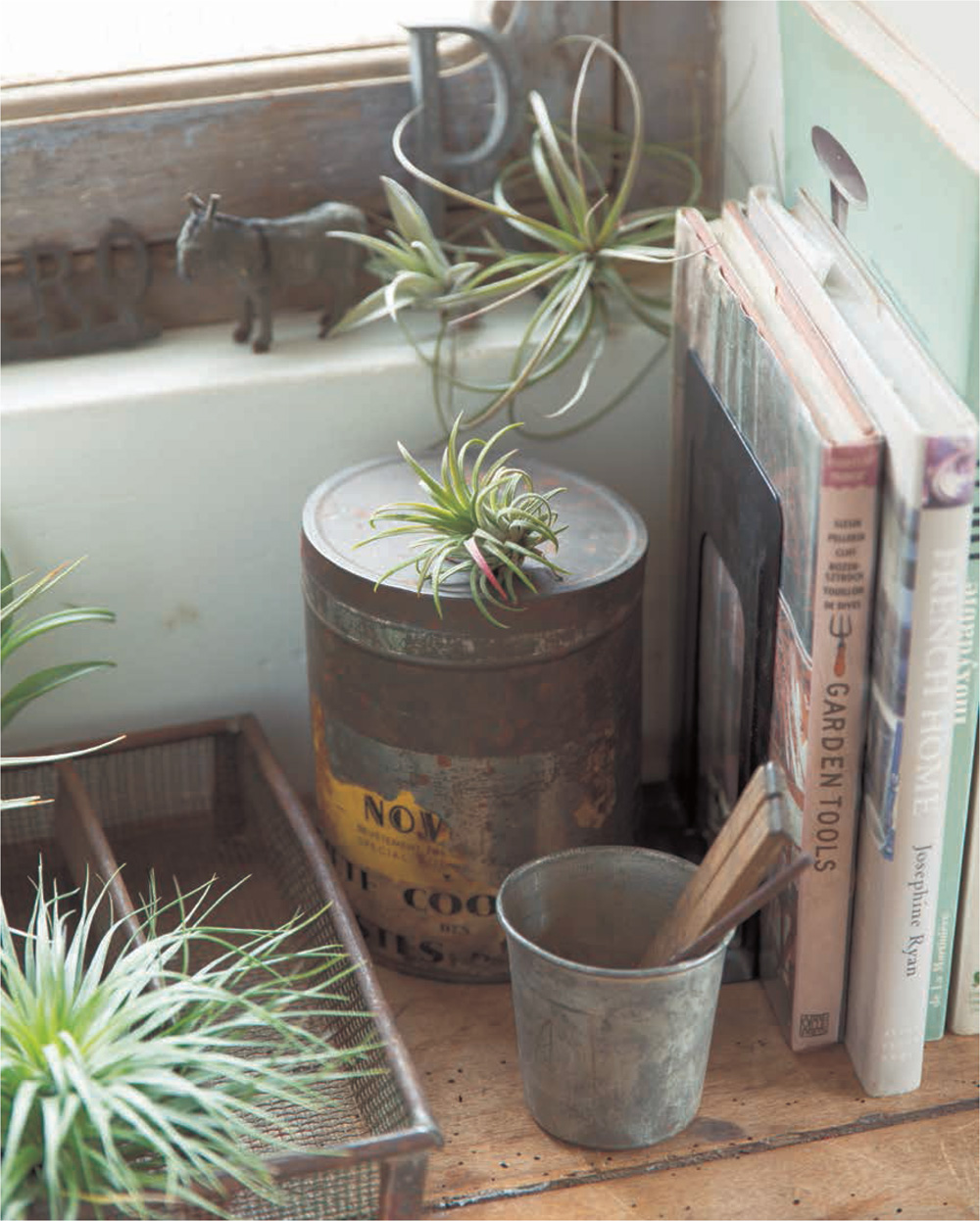 At the Tokyo garden shops where I work (Protoleaf Garden Island Tamagawa branch and Tukuriba Green Chofu branch) the number of customers looking for air plants is increasing to an overwhelming degree. Back in the day, customers were mainly enthusiasts seeking rare varieties, but these days, air plants are easy to find at nurseries, big chain stores, supermarkets, home improvement stores and so on, and are attracting more and more fans seeking a bit of versatile greenery. In the past, it was erroneously believed that air plants require no attention, probably leading to some unsuccessful attempts at growing them. Its true that air plants are resilient to dry conditions and are easy to cultivate, so they generally require less effort than other plants. Still, they do have their own needs. For example, although they love water, they dont do well in damp environments.
At the Tokyo garden shops where I work (Protoleaf Garden Island Tamagawa branch and Tukuriba Green Chofu branch) the number of customers looking for air plants is increasing to an overwhelming degree. Back in the day, customers were mainly enthusiasts seeking rare varieties, but these days, air plants are easy to find at nurseries, big chain stores, supermarkets, home improvement stores and so on, and are attracting more and more fans seeking a bit of versatile greenery. In the past, it was erroneously believed that air plants require no attention, probably leading to some unsuccessful attempts at growing them. Its true that air plants are resilient to dry conditions and are easy to cultivate, so they generally require less effort than other plants. Still, they do have their own needs. For example, although they love water, they dont do well in damp environments.
Additionally, air plants come in many different forms and each variety is suited to a slightly different environment. They will thrive if cultivated in a way suited to their variety. So to have real success with air plants, it helps to acquire some knowledge and a bit of experience with them. In this book we will cover how to cultivate air plants and provide you with a reference guide on the particular properties of each variety. Part of the fun of having air plants is that you can display them as they are, given that they do not need soil. Yukihiro Matsuda, from the popular variety store Brocante, shows us how to bring out their charm.
Their subtle colors fit into any interior and they complement succulents and other plants, so their unique appeal is sure to keep on growing. Discovering life with your favorite air plants is a thrillI hope you enjoy the ride. PROTOLEAF Yoshiharu Kashima Hardy and easy to cultivate! The Characteristics and Charm of Air Plants As long as care is taken with watering, ventilation and sunlight, air plants (Tillandsia) will grow. Since they dont need to be planted in soil, they make a unique piece of interior greenery and can be moved around like an ornament. Lets take a look at the characteristic hardiness and ease of cultivation that make them so appealing.  Water is absorbed through the leaves Air plants belong to the genus Tillandsia in the Bromeliad family and are native mainly to South and Central America, with around 600 original strains worldwide.
Water is absorbed through the leaves Air plants belong to the genus Tillandsia in the Bromeliad family and are native mainly to South and Central America, with around 600 original strains worldwide.
In their natural habitat, most air plants attach themselves to rocks, trees and plants such as cacti and grow by absorbing moisture from rain and fog. Their main characteristic is their ability to take in moisture through their leaves, aided by organs on the leaf surface called trichomes. For this reason, they can grow even if not planted in soil. Hardy plants resilient in dry conditions Air plants natural habitat varies from arid and alpine regions with little rainfall through to areas of rainforest. Essentially, they are able to live in harsh environments due to their ability to withstand dehydration and they rarely dry out. (Its said that the first time they entered Japan it was not as plants, but as packing material.) And these plants are generally as hardy as weeds, with significant capacity to adapt to their environment. 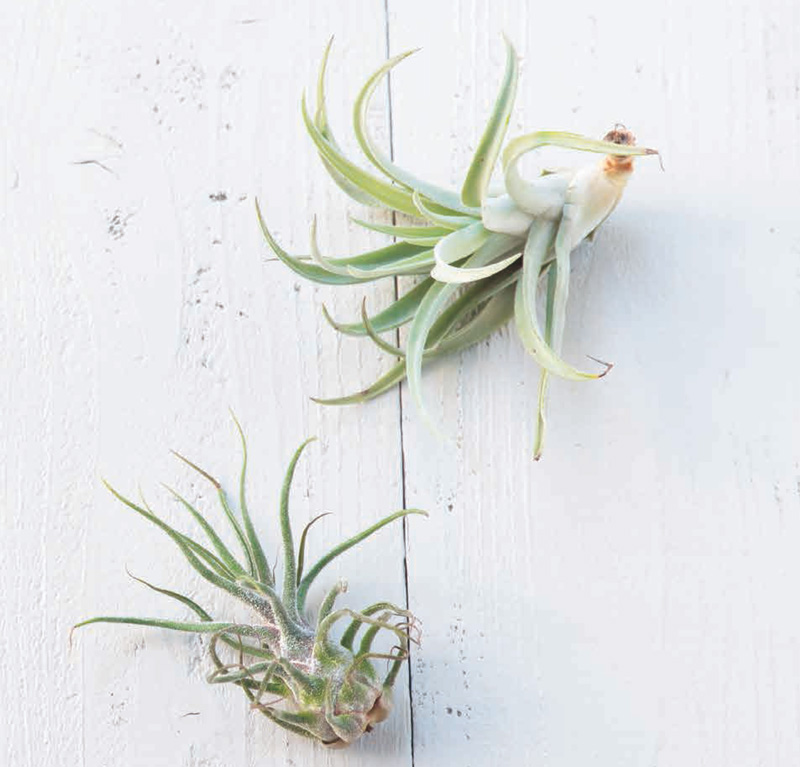 Ideal as indoor greenery As air plants can be cultivated without being planted in a pot or container, there is no need to worry about soil choices, care or mess.
Ideal as indoor greenery As air plants can be cultivated without being planted in a pot or container, there is no need to worry about soil choices, care or mess.  Ideal as indoor greenery As air plants can be cultivated without being planted in a pot or container, there is no need to worry about soil choices, care or mess.
Ideal as indoor greenery As air plants can be cultivated without being planted in a pot or container, there is no need to worry about soil choices, care or mess.
They are ideally suited as interior objects and indoor greenery. They can be simply placed on a tray or a shelf, wound around architraves to decorate walls, hung from railings and so on to be enjoyed for the dimension they create. Of course, watering and ventilation are essential, but if their various requirements are met, they are easily cultivated with no need for fuss. They complement ornamental plants, succulents, dried flower arrangements and so on, so try displaying them together. A variety of unique forms The appeal of air plants lies also in their unique form and appearance. They come in various forms, with some having leaves that curl irregularly at the tips, others that open out into attractive rosette shapes and others resembling round burrs.
Their leaves range from thin needle-like types to those like prickly grass, with others as soft as felt. Varying in size from dwarf plants as small as an index finger or that can fit on the palm of your hand through to giant, eye-catching types, some of their appeal lies in the pleasure that can be had in finding the best place to cultivate and display each plant to best show off its individualities. Terms Used for Parts of Air Plants The way that air plants flower, their leaf color, shape and so on vary depending on their type, but here we use the typical form of the Tillandsia geminiflora to explain the main parts of an air plant. 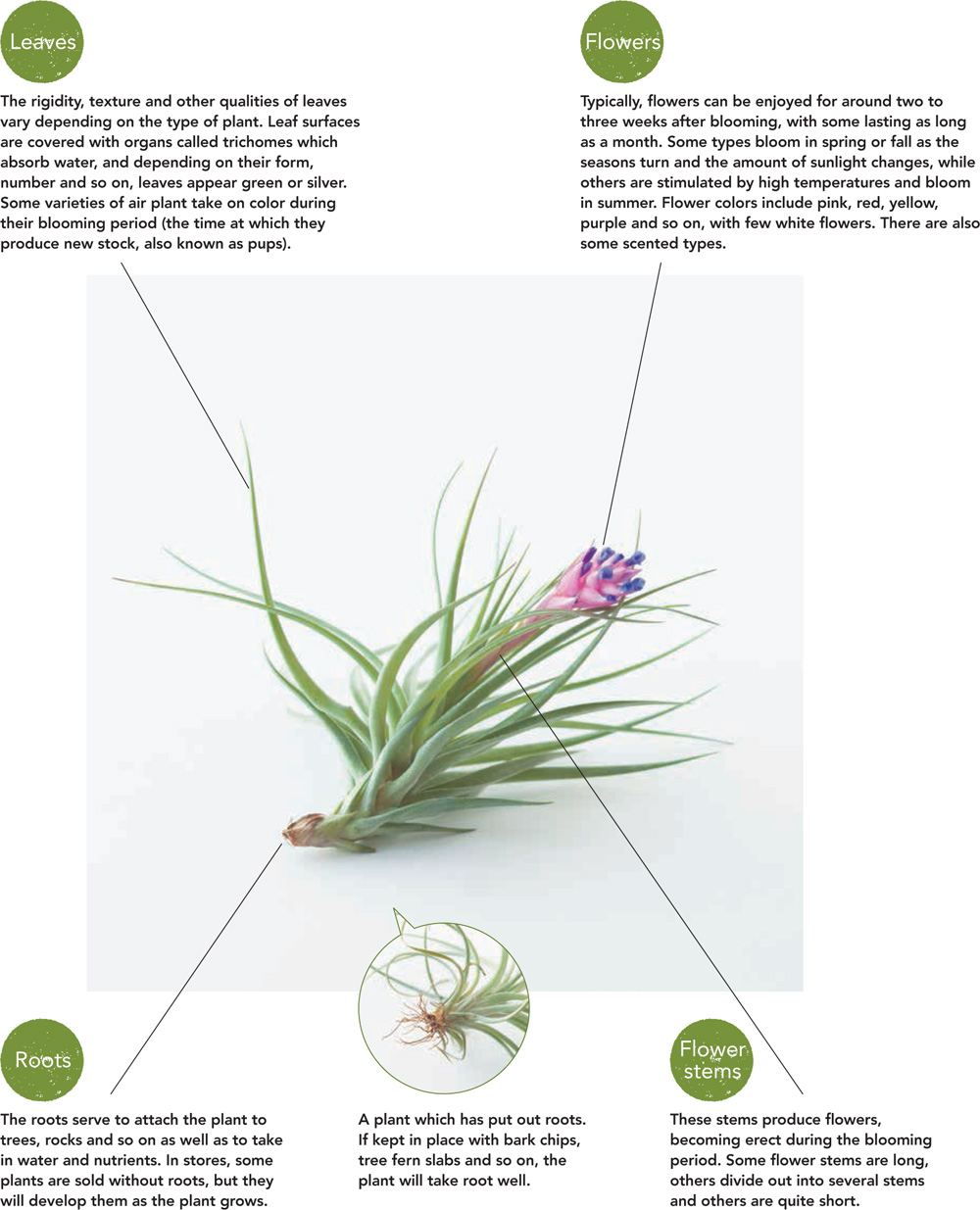 Part 1 Cultivating Air Plants Air plants can be enjoyed inside as low-maintenance indoor greenery, but by nature they prefer an outdoor environment where air circulates well. And although they are sturdy and tolerate dry conditions well, they love water. Because they are hardy and dont require soil, its easy to misunderstand and forget about their basic needs, but if properly cared for you will be able to enjoy them for a long time.
Part 1 Cultivating Air Plants Air plants can be enjoyed inside as low-maintenance indoor greenery, but by nature they prefer an outdoor environment where air circulates well. And although they are sturdy and tolerate dry conditions well, they love water. Because they are hardy and dont require soil, its easy to misunderstand and forget about their basic needs, but if properly cared for you will be able to enjoy them for a long time.
Firstly, learn about their key characteristics and appropriate environments to get the knack of cultivating them. This knowledge will help when you want to enjoy displaying them indoors. Main Types of Air PlantsPlants are divided by silver and green leaf color Leaf surfaces are covered with organs called trichomes that aid in the absorption of water. Leaf color differs depending on the form and number of trichomes, broadly dividing into silver foliage and green foliage types. Some types are difficult to classify clearly, but the amount of water and sunlight a plant needs can roughly be determined by this division, so it is useful as a reference when cultivating air plants. Plants with silver foliage grow relatively slowly, while green-leaved plants growth is more vigorous.
Next page
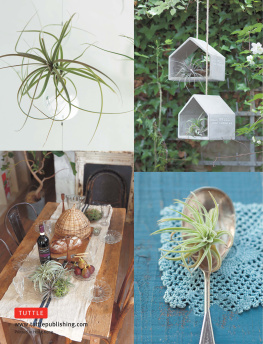

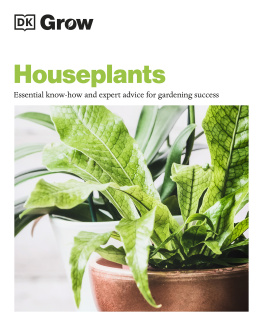
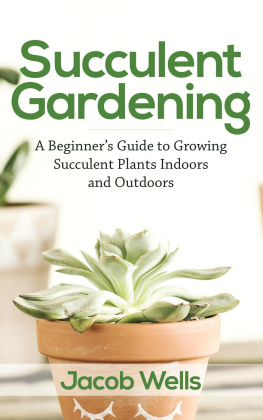
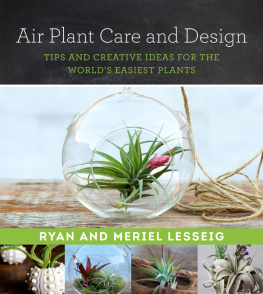
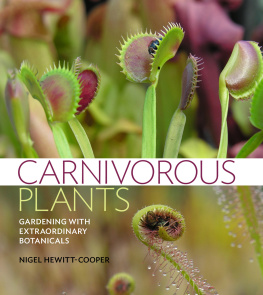
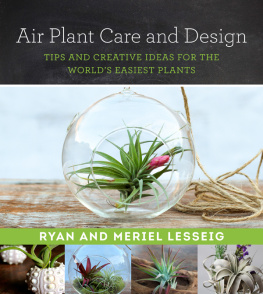


 LIVING WITH AIR PLANTS A Beginners Guide to Growing and Displaying Tillandsia
LIVING WITH AIR PLANTS A Beginners Guide to Growing and Displaying Tillandsia PROTOLEAF Yoshiharu Kashima BROCANTE Yukihiro Matsuda STYLING DIRECTION
PROTOLEAF Yoshiharu Kashima BROCANTE Yukihiro Matsuda STYLING DIRECTION  Authors Note
Authors Note At the Tokyo garden shops where I work (Protoleaf Garden Island Tamagawa branch and Tukuriba Green Chofu branch) the number of customers looking for air plants is increasing to an overwhelming degree. Back in the day, customers were mainly enthusiasts seeking rare varieties, but these days, air plants are easy to find at nurseries, big chain stores, supermarkets, home improvement stores and so on, and are attracting more and more fans seeking a bit of versatile greenery. In the past, it was erroneously believed that air plants require no attention, probably leading to some unsuccessful attempts at growing them. Its true that air plants are resilient to dry conditions and are easy to cultivate, so they generally require less effort than other plants. Still, they do have their own needs. For example, although they love water, they dont do well in damp environments.
At the Tokyo garden shops where I work (Protoleaf Garden Island Tamagawa branch and Tukuriba Green Chofu branch) the number of customers looking for air plants is increasing to an overwhelming degree. Back in the day, customers were mainly enthusiasts seeking rare varieties, but these days, air plants are easy to find at nurseries, big chain stores, supermarkets, home improvement stores and so on, and are attracting more and more fans seeking a bit of versatile greenery. In the past, it was erroneously believed that air plants require no attention, probably leading to some unsuccessful attempts at growing them. Its true that air plants are resilient to dry conditions and are easy to cultivate, so they generally require less effort than other plants. Still, they do have their own needs. For example, although they love water, they dont do well in damp environments. Water is absorbed through the leaves Air plants belong to the genus Tillandsia in the Bromeliad family and are native mainly to South and Central America, with around 600 original strains worldwide.
Water is absorbed through the leaves Air plants belong to the genus Tillandsia in the Bromeliad family and are native mainly to South and Central America, with around 600 original strains worldwide. Ideal as indoor greenery As air plants can be cultivated without being planted in a pot or container, there is no need to worry about soil choices, care or mess.
Ideal as indoor greenery As air plants can be cultivated without being planted in a pot or container, there is no need to worry about soil choices, care or mess.  Part 1 Cultivating Air Plants Air plants can be enjoyed inside as low-maintenance indoor greenery, but by nature they prefer an outdoor environment where air circulates well. And although they are sturdy and tolerate dry conditions well, they love water. Because they are hardy and dont require soil, its easy to misunderstand and forget about their basic needs, but if properly cared for you will be able to enjoy them for a long time.
Part 1 Cultivating Air Plants Air plants can be enjoyed inside as low-maintenance indoor greenery, but by nature they prefer an outdoor environment where air circulates well. And although they are sturdy and tolerate dry conditions well, they love water. Because they are hardy and dont require soil, its easy to misunderstand and forget about their basic needs, but if properly cared for you will be able to enjoy them for a long time.